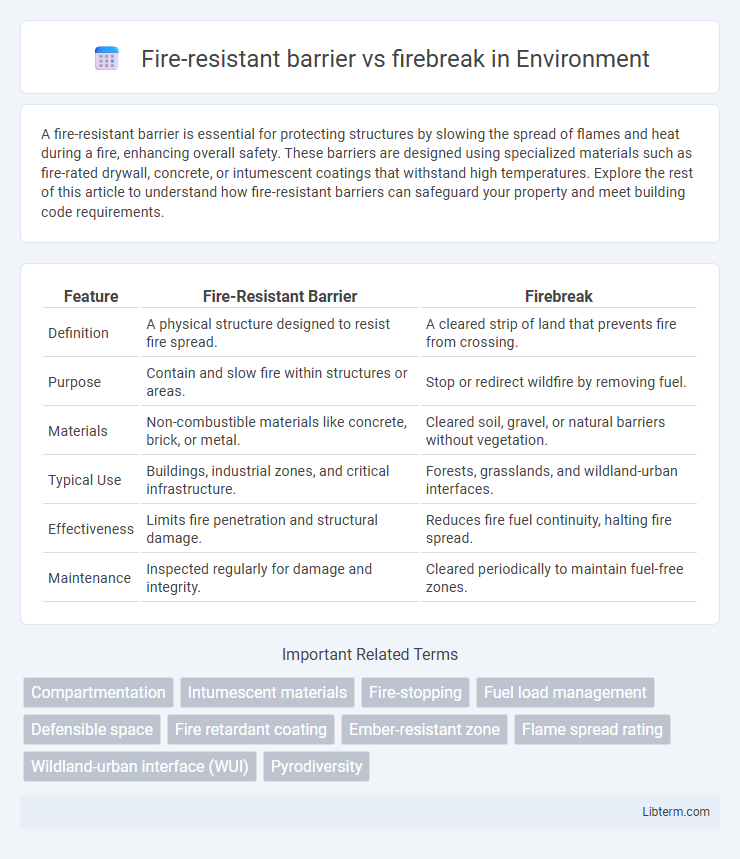A fire-resistant barrier is essential for protecting structures by slowing the spread of flames and heat during a fire, enhancing overall safety. These barriers are designed using specialized materials such as fire-rated drywall, concrete, or intumescent coatings that withstand high temperatures. Explore the rest of this article to understand how fire-resistant barriers can safeguard your property and meet building code requirements.
Table of Comparison
| Feature | Fire-Resistant Barrier | Firebreak |
|---|---|---|
| Definition | A physical structure designed to resist fire spread. | A cleared strip of land that prevents fire from crossing. |
| Purpose | Contain and slow fire within structures or areas. | Stop or redirect wildfire by removing fuel. |
| Materials | Non-combustible materials like concrete, brick, or metal. | Cleared soil, gravel, or natural barriers without vegetation. |
| Typical Use | Buildings, industrial zones, and critical infrastructure. | Forests, grasslands, and wildland-urban interfaces. |
| Effectiveness | Limits fire penetration and structural damage. | Reduces fire fuel continuity, halting fire spread. |
| Maintenance | Inspected regularly for damage and integrity. | Cleared periodically to maintain fuel-free zones. |
Introduction to Fire-resistant Barriers and Firebreaks
Fire-resistant barriers are engineered structures or materials designed to prevent the spread of fire within buildings by compartmentalizing spaces and maintaining structural integrity under high temperatures. Firebreaks, on the other hand, are strategically cleared zones in vegetation or landscapes devoid of combustible material to halt or slow wildfire progression. Both fire-resistant barriers and firebreaks serve critical roles in fire safety management by minimizing fire damage and enhancing containment efforts.
Defining Fire-resistant Barriers
Fire-resistant barriers are specially designed structural elements that prevent the spread of fire by containing flames and heat within designated compartments of a building. These barriers are constructed using fire-resistant materials such as gypsum boards, concrete, or fire-rated glass to achieve a specific fire-resistance rating, often tested under standardized conditions. Unlike firebreaks that are typically open spaces or non-combustible zones in wildland areas to stop wildfires, fire-resistant barriers are integral components within buildings aimed at protecting occupants and critical infrastructure.
Understanding Firebreaks
Firebreaks are strategic gaps or cleared areas designed to halt or slow the spread of wildfires by removing combustible vegetation and other flammable materials, effectively interrupting the fire's fuel continuity. Unlike fire-resistant barriers that rely on fire-retardant materials or construction techniques to withstand fire exposure, firebreaks function primarily through the absence of fuel, creating a physical separation within the landscape. Understanding firebreaks involves recognizing their critical role in wildfire management by reducing fire intensity and providing safe zones for firefighting efforts.
Key Differences Between Barriers and Breaks
Fire-resistant barriers are physical structures designed to prevent the spread of fire by containing flames and heat within a designated area, often constructed using fire-resistant materials like concrete or fire-rated drywall. Firebreaks, on the other hand, are cleared or natural gaps in vegetation or combustible materials that interrupt fuel continuity, reducing wildfire spread. The key differences lie in their purpose and form: barriers act as protective walls to block fire passage, while break functions as open spaces that halt or slow fire movement by removing fuel sources.
Materials Used in Fire-resistant Barriers
Fire-resistant barriers commonly utilize materials such as gypsum boards, mineral wool, concrete, and intumescent coatings designed to withstand high temperatures and prevent fire spread. These materials provide thermal insulation and structural integrity, maintaining the barrier's function during prolonged exposure to flames. Unlike firebreaks, which often rely on cleared vegetation or non-combustible zones, fire-resistant barriers are constructed with engineered, fire-retardant substances tailored for building protection and compartmentalization.
Types of Firebreaks and Their Construction
Firebreaks are categorized into natural and artificial types, with natural firebreaks including rivers, roads, and barren land, while artificial firebreaks involve human-made clearings or barriers like trenches or fuel breaks. Construction of firebreaks typically requires removal of combustible materials to create a gap that stops or slows the spread of wildfire, often maintained by controlled burns or mechanical clearing. Fire-resistant barriers, distinct from firebreaks, use fire-retardant materials or assemblies installed in buildings to resist fire penetration for a specified duration.
Effectiveness in Wildfire Prevention
Fire-resistant barriers, made from non-combustible materials like concrete or metal, effectively slow fire spread by blocking flames and heat transfer. Firebreaks, typically clear strips of land devoid of vegetation, reduce fire fuel and create strategic gaps to stop wildfire progression. Combining both strategies enhances wildfire prevention by minimizing ignition sources and interrupting fire pathways.
Maintenance and Longevity Considerations
Fire-resistant barriers require regular inspection and maintenance to ensure their integrity, including checking for cracks, gaps, or any damage that could compromise fire resistance. Firebreaks, being open spaces clear of vegetation, demand ongoing vegetation management and debris removal to prevent fire spread effectively. Longevity of fire-resistant barriers depends on the quality of materials and environmental exposure, while firebreaks rely on consistent upkeep to maintain their protective function over time.
Applications in Urban and Rural Settings
Fire-resistant barriers are structural elements designed to prevent fire spread within buildings and urban infrastructure, commonly applied in walls, floors, and doors to protect high-density residential and commercial areas. Firebreaks, typically used in rural and wildland-urban interface zones, consist of cleared vegetation strips that slow or stop wildfire progression by removing flammable material. Urban settings prioritize fire-resistant barriers to enhance building safety and compliance with fire codes, while rural applications rely on firebreaks for landscape-scale wildfire management and controlling fire spread through natural environments.
Choosing the Right Solution for Fire Protection
Fire-resistant barriers provide continuous protection by slowing fire spread through walls or floors, essential in buildings requiring compartmentalization, while firebreaks act as open gaps in vegetation or materials that stop fire from advancing in wildland or industrial settings. Selecting the right solution depends on the environment: fire-resistant barriers suit structural fire safety mandates, whereas firebreaks are effective in landscape management and wildfire control. Understanding the specific fire risks, material properties, and regulatory requirements guides optimal fire protection strategy.
Fire-resistant barrier Infographic

 libterm.com
libterm.com